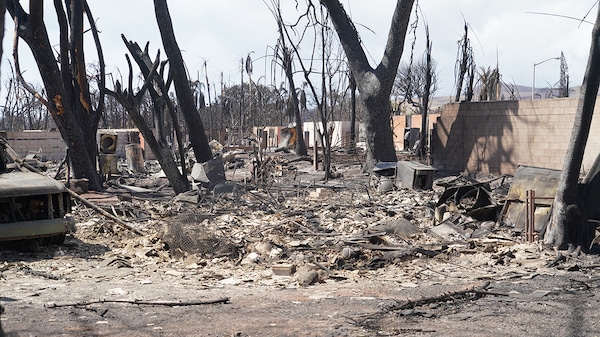On August 8, one of the deadliest wildfires in the 21st century broke out on the island of Maui, Hawaii. Aerial photos show the effect of the devastation, with the historic city of Lahaina going from a thriving, lush greenscape to a burned husk of destroyed buildings and wildlife. The fires still rage and as of today have taken over 100 lives, with the death toll certain to grow due to the slow pace of identifying fire victims on the remote island. As of Tuesday, August 15, search dog teams from outside the island chain have only searched around 32% of the disaster zone.
According to Kaniela Ing, former Hawaiian legislator and the director of the Green New Deal Network, the wildfires are “a tragic symbol of the climate emergency and colonial greed.” Lahaina, which experienced much of the worst devastation, was once the seat of the independent Hawaiian government kingdom years before it was toppled and annexed by the United States in the 1890s. Some of the most precious historic sites of an independent Hawaii were destroyed in the fires.
Ing claims that the “the gross mismanagement of land by greedy developers and land speculators destroyed our natural landscape and buffers and enabled the rapid spread of the fire.”
Housing crisis
The Maui Emergency Management Agency estimates that it will cost USD 5.52 billion to rebuild from the damage. At least 2,200 buildings have been destroyed or damaged in the fire, with 86% of those being residential. 4,500 of the population of the island are now in need of shelter.
As thousands seek shelter, the fires in Maui have exposed the growing housing crisis in Hawai’i. Indigenous Hawaiians are struggling to maintain shelter with a booming tourism industry driving up prices. The cost of living in Hawaii is almost twice the U.S. average (key to note that Hawaiian independence activists protest the island chain’s default inclusion as a part of the US). The median price of a single family home in Maui is USD 1.2 million, and the median condo price is USD 850,000. The minimum wage in Hawaii is only USD 12 per hour, although a state analysis revealed that a single person working 40 hours per week would need to make at least USD 18 per hour in order to afford basic necessities. The racial groups with the highest poverty rates are Native Hawaiians and other Pacific Islanders.
Many residents worry that any homes rebuilt following the fires will conform to the skyrocketing housing costs. And with the differing poverty rates by race, those housing costs have in fact discriminated against Indigenous Hawaiians. This is revealed by the crisis of gentrification on the island, which the fire may only exacerbate. Sterling Higa, executive director of Housing Hawaii’s Future, told the Associated Press that,
a lot of more recent arrivals—typically from the [US] who have more money and can buy homes at a higher price—were to some extent displacing local families in Lahaina.
Over half of all homeless people on the Hawaiian island of Oahu, the most populated of the Hawaiian island chain, identified as Native Americans or Pacific Islanders. Local activists have also alerted about real estate agents taking advantage of the devastating fires to make a quick buck off of vacated Hawaiian land.
Climate change
As the New York Times reports, the area burned by wildfires in Hawai’i has quadrupled in recent decades.
Climate change has played a significant role in the increase in fires, as dry and hot conditions have worsened across the islands. 16% of Maui, specifically the western side where the fires have been blazing, had been experiencing severe drought conditions a week ago. In June, the Maui government leveled water restrictions on residents due to the drought, which started in May. Residents were fined USD 500 for using water for “non-essential” needs, such as washing cars. However, the tourism industry experienced no such penalty despite accounting for nearly half of Hawaii’s water consumption.
The legacy of colonialism
Hawaiian independence activists point out that the contradictions between the Indigenous Hawaiians contending with drought and being pushed out of their homes are really part and parcel of the legacy of colonialism on the island chain.
In an interview with Democracy Now!, Kaleikoa Kaeo, activist and professor of Hawaiian studies at the University of Hawai’i Maui College spoke about how the transformation of of Lahaina from the seat of the independent Hawaiian kingdom to what it is now is part of how “the economy, the population and the landscape itself was transformed, really, to meet the needs of mass tourism.”
Now Maui is a tourist’s paradise, even after the wildfires. A Hawaiʻian woman expressed her horror to the BBC after seeing tourists swimming in “the same waters that our people just died in three days ago.”
“There is two Hawaiʻis right now,” she continued.
There’s the Hawaii we’re living in and the Hawaii they’re living in—they’re visiting in.
Lahaina used to be a wetland. It was the process of colonization that turned the land arid and wildfire-prone. “The major area in Lahaina, one of the names, in fact, was Waine’e. The word wai means ‘water.’ The word ne’e means ‘to move,’” says Professor Kaeo.
Unfortunately, today, most of that water no longer exists due to streams which have been diverted, you know, the transformation of the environment from traditional native plants and so-called forests, which have [been] replaced first by sugar and then, now, unfortunately, being replaced by these what we call gentlemen estates… there’s a transformation, where Lahaina at one time was a very important agricultural center, commercial trade center through the whaling period, and then became a large sugar plantation area.
The invasive, nonnative grass species that provided a tinderbox for the wildfires was introduced by 19th century settlers building up large-scale agriculture.
“Unfortunately and horrifically, our people, who have lived there since time immemorial, are suffering because of the consequences that have been imposed, really, from outside forces,” says Kaeo.

